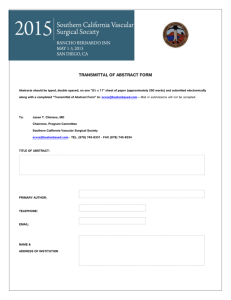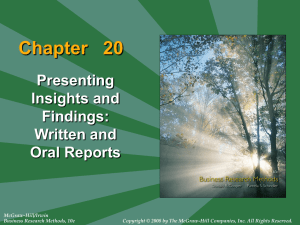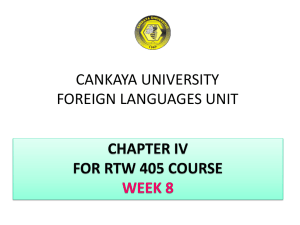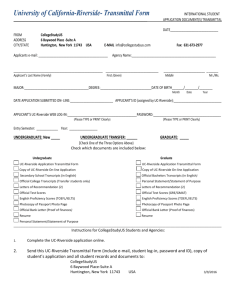Research Presentations
advertisement
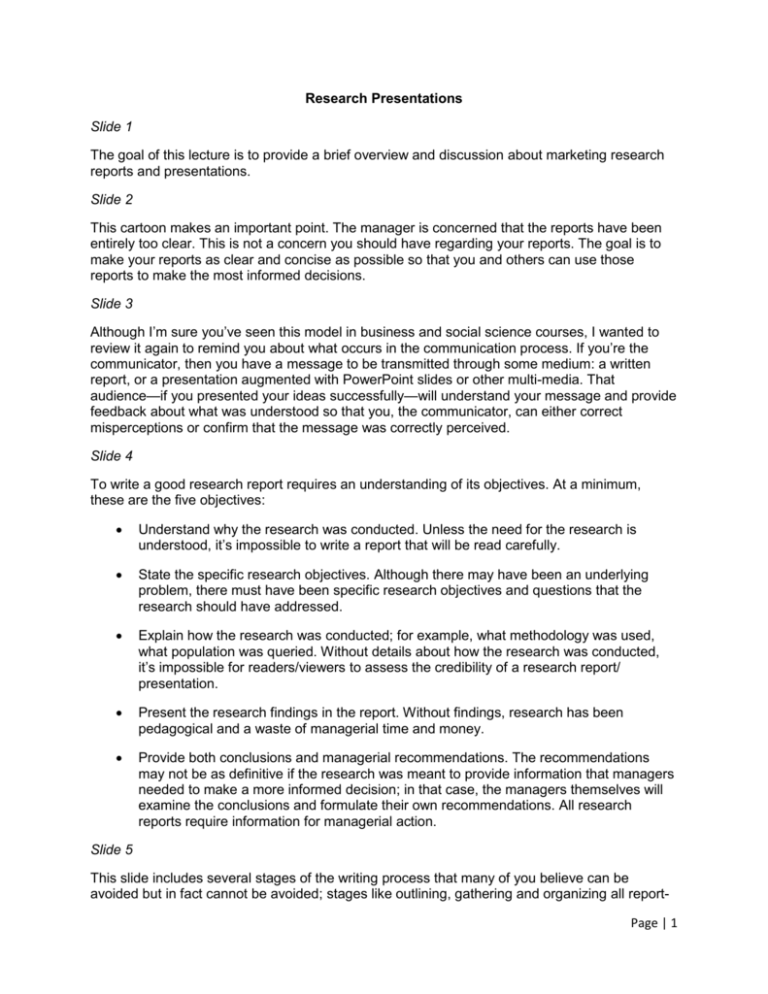
Research Presentations Slide 1 The goal of this lecture is to provide a brief overview and discussion about marketing research reports and presentations. Slide 2 This cartoon makes an important point. The manager is concerned that the reports have been entirely too clear. This is not a concern you should have regarding your reports. The goal is to make your reports as clear and concise as possible so that you and others can use those reports to make the most informed decisions. Slide 3 Although I’m sure you’ve seen this model in business and social science courses, I wanted to review it again to remind you about what occurs in the communication process. If you’re the communicator, then you have a message to be transmitted through some medium: a written report, or a presentation augmented with PowerPoint slides or other multi-media. That audience—if you presented your ideas successfully—will understand your message and provide feedback about what was understood so that you, the communicator, can either correct misperceptions or confirm that the message was correctly perceived. Slide 4 To write a good research report requires an understanding of its objectives. At a minimum, these are the five objectives: Understand why the research was conducted. Unless the need for the research is understood, it’s impossible to write a report that will be read carefully. State the specific research objectives. Although there may have been an underlying problem, there must have been specific research objectives and questions that the research should have addressed. Explain how the research was conducted; for example, what methodology was used, what population was queried. Without details about how the research was conducted, it’s impossible for readers/viewers to assess the credibility of a research report/ presentation. Present the research findings in the report. Without findings, research has been pedagogical and a waste of managerial time and money. Provide both conclusions and managerial recommendations. The recommendations may not be as definitive if the research was meant to provide information that managers needed to make a more informed decision; in that case, the managers themselves will examine the conclusions and formulate their own recommendations. All research reports require information for managerial action. Slide 5 This slide includes several stages of the writing process that many of you believe can be avoided but in fact cannot be avoided; stages like outlining, gathering and organizing all reportPage | 1 related materials, and writing a first draft (instead of submitting final copy in one pass). A good research report requires multiple re-writes to improve its readability, to correct grammatical or spelling errors, to evaluate its appropriateness, and to evaluate its content. So, plan to gather your materials, organize them, create an outline, write a first draft, and re-write that first draft several times to improve its readability, it’s grammatical and spelling correctness, and its appropriateness for the audience (especially in terms of content). Slide 6 For those of you who prefer diagrams or flow charts, here is an excellent one. It indicates the prefatory parts, the main body and intended parts of the reports. The prefatory part includes; title page, letter of transmittal, table of contents, and any kinds of summaries. The main body includes; the introduction, a lengthy discussion of methodology, results, limitations, and conclusions. The appendices would include; data forms, questionnaires, special calculations that were made, table from which conclusions and recommendations were drawn, and relevant secondary sources that were used to create the report listed in a bibliography. Slide 7 Although the previous slide suggested that comprehensive reports require the highest level of formality, this slide indicates that certain components of a report may be omitted as the need for formality diminishes. Slide 8 This slide shows a good example of a letter of transmittal, which often prefaces research reports. Slide 9 For reports that require an executive summary—and most do—that summary should indicate why the research was conducted, what was found, what the findings mean, and what action the manager should take based on those findings. Slide 10 If you prefer lists, here are several slides that indicate the appropriate organization for a research report. First, you would include a table of contents. Second, research background and objectives are needed. Third, a two-to-four page executive summary should include findings, conclusions, and recommendations. Fourth, a two-to-five page methodological discussion should describe how the research was conducted. If more detail is required, include that in an appendix. Slide 11 The next section of the report should include findings presented in a detailed manner. This is the guts of the report and the part that managers will attend to most in making decisions. The remainder of the report is to support the credibility of findings. If managers aren’t convinced that the appropriate methodology was used, then they will discount the findings heavily. Then conclusions and (depending on the need) recommendations would be presented. Finally, technical appendices—with content like copies of questionnaires, statistical tables, supporting materials, and secondary sources materials—would be included. It’s typical for a research report to include more than 50% appendices. Page | 2 Slide 12 To make a research reports readable and user friendly, needless words should be minimized, as wordiness is an ineffective way to make a point. Instead of long and wordy paragraphs, try to provide bullet points and charts, as they are more powerful than page after page of prose. Slide 13 Consider this list of warnings about marketing research reports. Length doesn’t mean quality. A long report could be based on flawed methodology or be a poorly written one with high redundancy. Marketing managers recognize the quality of the report is not equivalent to its length. Be sure to provide sufficient explanations of underlying methodologies and the aspects of the research that might concern a technically versed person. Insufficient explanations could compromise the researcher’s credibility with managers who are knowledgeable about research and research methods. Be sure to relate the report to the clients’/managers’ objectives. It’s important to know the objectives and ensure the process and report stick to them. Don’t use of quantitative methods indiscriminately. In other words, trying to dazzle with B.S. is a bad strategy. If quantitative methods are required, then they should be used appropriately. This means simple and direct methods are used when appropriate. If simple t and F-tests are sufficient, then there’s no reason to use more sophisticated multi-variable statistics. It’s unlikely that managers will be versed in those methods; hence, they will tend to ignore such quantitative results. My consulting experience suggests that managers were most comfortable with simple graphics, frequency tables, and cross-tabulation tables. Anything beyond those graphics/tables and a simple t test created mental overloaded for most managers I knew. Avoid false accuracy. If data is scaled from 1 to 7, then it’s nonsensical to report mean scores to 1/10,000th of a unit. If people only can provide single digit accuracy in their responses, then reporting means in more than tenths is false accuracy and gives the impression that the results are more precise than is the case. Provide confidence intervals (or ranges for the likely mean) rather than single point estimates. Although researchers can calculate mean scores on the data they collected, those scores represent only one possible outcome. If the study was run again, the odds of those identical mean scores is close to zero. It’s more honest to present the manager with a range; here’s the score, but it’s plus or minus ‘x’. That provides the manager with a better sense for how to use the information. Telling a manager 20% is one thing, but telling that manager 20% +/-10% means something else entirely. Avoid inaccurate data interpretation. The use of statistical methods helps to summarize large quantities of data. Occasionally, unknowledgeable researchers apply those methods inappropriately. As a result, data interpretation is meaningless. Even if the data are properly analyzed, it’s possible for a researcher to draw an erroneous conclusion. Page | 3 Slide 14 My final comment about written reports is summarized by this cute little poem. Running this poem through a spell checker will produce no errors, yet there are several. If you care about the impression your report makes, you’ll run it through a spell checker, but that shouldn’t be the limit to the error checking will perform. Spell checkers and grammar checkers are good starting points, but not a good finishing point. To ensure that a report is as error free as possible, multiple proofreaders are required. Slide 15 These last two slides address personal presentations, which frequently are made in a marketing research context. After you’ve completed the research and written a report, you need to present that report. Before making your presentation, you might want to consider these questions: What do the data mean? What impact do they have? What have I learned from the data? What does the information suggest about a course of action? How can future studies of this nature be enhanced? What can make information like this more useful? Slide 16 Whether a presentation of the research you may have conducted as a requirement for this course, or a presentation of research you might conduct in the future, you should consider creating the following materials and providing them to the audience. Certainly, you should provide a presentation outline using software like PowerPoint. You should provide visuals— either in slide or overhead form—as someone who talks incessantly without visuals becomes very dull. You should provide an executive summary and make copies of the final report for those in the audience who may be interested in one. Although this is not typical, it’s better to be prepared. Page | 4

